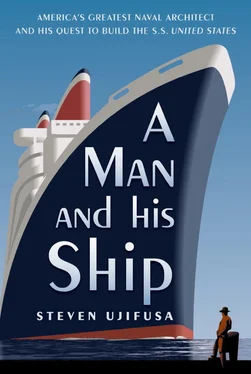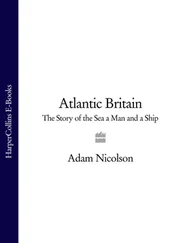Below the Gibbs boys, Mauretania ’s hundreds of electric lights cast a bright glow on the crowds and flickered off the gray harbor waters. Wisps of black coal smoke curled lazily from the ship’s four red-and-black stacks, each of which towered several stories above her brilliantly illuminated uppermost decks. On board, first-class passengers unpacked in their staterooms and then explored the public rooms, all paneled in gilt-trimmed walnut, sycamore, and mahogany carved by three hundred artisans brought in from Palestine. 3She looked like a British country house put to sea. Gone were the days of the nineteenth-century wooden paddle-wheel steamer, with its stiff bunks, chamber pots, and pervasive stink of bilgewater. On board Mauretania, men dressed for dinner in white tie and tails, women retrieved their jewels from the purser’s office, and the first-class kitchen rivaled the one at the London Ritz. Sheets were changed each day, fresh flowers bloomed in the foyers, and an onboard printing press churned out menus and newspapers for two thousand passengers in three classes. Second-class passengers enjoyed spacious public rooms comparable to first-class spaces on older vessels. Those traveling steerage had private staterooms rather than open dormitories, as well as their own deck space.
The modern ocean liner, a swift and sleek city afloat, had arrived.
As Mauretania headed out to sea, William Francis and Frederic Gibbs inspected the new Cunard superliner. They marveled at the two-deck-high first-class dining saloon, the newfangled electric elevators, and the lounge with its frosted glass dome. Strains of Strauss’s “Blue Danube” and Léhar’s “Merry Widow” accompanied passengers at dinner. There was at least one Philadelphian on board whom the Gibbs brothers may have chatted with at dinner: Anthony Drexel Jr., the Philadelphia banker who had sold 1733 Walnut Street to their father; Drexel booked one of the liner’s Regal Suites, which went for $1,500 per person one-way (almost $35,000 today). 4First class aboard Mauretania was a luxurious, civilized sphere to which the Gibbs brothers had been accustomed since birth.
As splendid as the new ship was, what interested the Gibbs boys most was what was pulsing steadily beneath their feet. Lusitania and Mauretania were not only the two largest liners in the world, but the first Blue Riband contenders to use a new kind of engine: the steam turbine. And watching a great ship’s engines, William Francis would later say, gave him the same thrill as listening to the music of Bach. 5
Germany’s four turn-of-the-century Blue Riband holders— Kaiser Wilhelm der Grosse, Deutschland, Kronprinz Wilhelm, and Kaiser Wilhelm II —all used massive quadruple reciprocating expansion engines, whose four steam chambers produced maximum power for an otherwise traditional piston engine. By 1900, reciprocating engines had hit a brick wall in terms of horsepower—they were getting too big and heavy, and it seemed that 23 knots was the maximum speed a big ship could reach. Even worse, as thumping pistons turned twin propeller shafts, the German ships shook, quite literally from stem to stern. Glasses crashed off tables and bunks trembled all night long. Many sleep-deprived travelers called the hard-riding HAPAG record breaker Deutschland the “Cocktail Shaker.” 6
The new British ships, on the other hand, took advantage of an experimental power plant, invented in 1884 by Charles Parsons. The steam turbine operated on the same principle as a windmill. High-pressure steam from the boilers would be blasted against a rotor lined with thousands of tiny blades. The spinning rotor would be connected to a propeller shaft. The result was a faster, more efficient engine that took up much less space.
Parsons demonstrated just how good his engine was when he crashed the 1897 Naval Review at Spithead. The event, meant to celebrate Queen Victoria’s Diamond Jubilee, turned into a vehicle for Charles Parsons to promote his hundred-foot-long Turbinia. A brash Parsons zipped his nimble craft between battleships and cruisers at an incredible 34 knots (39 land miles per hour), evading a pursuing navy pilot boat. Even the aged Queen Victoria was astonished by the performance of the strange craft. Although many in the Royal Navy were outraged, others took notice and began to investigate installing turbines on new British warships. 7
The steam turbine proved to be one of the greatest breakthroughs in engineering history, allowing ships to achieve unprecedented speeds. In 1906, the debut of the British battleship HMS Dreadnought, the first large warship to abandon the traditional reciprocating engine, intensified the ongoing naval arms race between Great Britain and Germany. With turbines connected to quadruple screws, Dreadnought could cruise at a steady 21 knots, making her the fastest battleship in the world. Yet even before launch of the Dreadnought, British engineers had already adopted turbine technology for use in passenger ships. In 1905, Cunard built two large sister ships: one was powered by reciprocating engines, while the other by Parsons turbines. The turbine vessel proved to be more than a knot faster, as well as quieter and more economical to operate. 8
Cunard was finally sold on turbines. They were installed in both Lusitania and Mauretania, and there were more innovations as well. For the first time on a commercial liner, the ships would have not two, but four propellers. The arrangement meant engine torque would be more evenly distributed, lessening the risk of breakdown. Inspired to match the powerful physical appearance of the German ships, the designers gave each ship four raked funnels, wide and long enough to fit a locomotive inside. And while the engines of the Norddeutscher Lloyd flagship Kaiser Wilhelm II were rated at 45,000 horsepower, those of the Cunard ships were each rated at over 70,000.
The contract to build Lusitania was awarded to John Brown & Company of Clydebank, Scotland. Mauretania ’s went to Swan, Hunter & Wigham in Newcastle-upon-Tyne, England, with engine construction subcontracted to Andrew Laing at Wallsend. The two-contract arrangement stoked Andrew Laing’s competitive fires. From the start, it appeared that the Swan, Hunter–built ship would be the mechanically superior of the two. To make his engines lighter than Lusitania’s, Laing chose a new steel alloy called Whitworth fluid-pressed steel for many of the turbine elements. Laing also eliminated extra parts to ensure that the assemblies would have “maximum strength and rigidity with a minimum weight.” Each ten-foot-diameter rotor was strung with three million tiny blades. The completed rotor was then placed inside a cast-iron casing. 9Because of clearances of only a tenth of an inch, the slightest defect along the rotor’s forty-five-foot length would cause the blades to rub against the turbine casing and strip them, completely destroying the engine. But when run for the first time, less than a week before her November 7 trials, the turbines spun in perfect balance. 10
Everyone aboard Mauretania, including the Gibbs brothers, thought that their ship would take the Blue Riband on her maiden voyage in November 1907. But as soon as she left the Irish coast behind, a terrific autumn gale hit the liner. Great waves lifted the bow sixty feet into the air only to send it smacking back down, unleashing gigantic bursts of spray. Despite her smoother turbine power plant, engineers at the trial runs noticed that vibration from Mauretania ’s four thrashing propellers sent shudders throughout the entire ship, and so they had added stiffeners throughout the stern to solve the problem. The storm on this maiden voyage made any vibration problems irrelevant to her passengers— Mauretania ’s relatively slim underwater hull made her a bad roller.
Читать дальше












